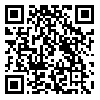Thu, Nov 13, 2025
[Archive]
Volume 12, Issue 3 (7-2022)
Iran J Ped Hematol Oncol 2022, 12(3): 190-198 |
Back to browse issues page
Download citation:
BibTeX | RIS | EndNote | Medlars | ProCite | Reference Manager | RefWorks
Send citation to:



BibTeX | RIS | EndNote | Medlars | ProCite | Reference Manager | RefWorks
Send citation to:
Pouladi A, Ghanei Gheshlagh R, Kahrizi N, Roshani D, Jalali C, Moradveisi B. The spectrum of Alpha and Beta Thalassemia Mutations: A 10-year Population-based Study of the Premarital Health Screening Program in West of Iran. Iran J Ped Hematol Oncol 2022; 12 (3) :190-198
URL: http://ijpho.ssu.ac.ir/article-1-656-en.html
URL: http://ijpho.ssu.ac.ir/article-1-656-en.html
Arash Pouladi 
 , Reza Ghanei Gheshlagh
, Reza Ghanei Gheshlagh 
 , Nahid Kahrizi
, Nahid Kahrizi 
 , Daem Roshani
, Daem Roshani 
 , Chia Jalali
, Chia Jalali 
 , Borhan Moradveisi *
, Borhan Moradveisi * 


 , Reza Ghanei Gheshlagh
, Reza Ghanei Gheshlagh 
 , Nahid Kahrizi
, Nahid Kahrizi 
 , Daem Roshani
, Daem Roshani 
 , Chia Jalali
, Chia Jalali 
 , Borhan Moradveisi *
, Borhan Moradveisi * 

Cancer and Immunology Research Center, Research Institute for Health Development, Kurdistan University of Medical Sciences, Sanandaj, Iran.
Abstract: (1552 Views)
Background: In various cancers, Ganoderic Acid A (GAA), an active triterpenoid derived from Ganoderma Background: Thalassemia refers to a category of inherited disorders resulting from defects in synthesizing one or several chains of hemoglobin (Hb). The present study aimed to determine the frequency of alpha and beta-thalassemia mutations in Kurdistan province, Iran.
Materials and Methods: In this retrospective cross-sectional study, the laboratory data of 340 patients with thalassemia (170 females and 170 males), who were candidates for genetic testing in Kurdistan province, were examined over ten years (2006-2016). The participants were Kurd couples selected from the premarital health screening program.
Results: In this demographic study, 20 beta mutations and nine alpha mutations were identified. Among the beta-thalassemia mutations, intervening sequence or intron No. 2- first nucleotide change as splice site mutation (IVS-II-1) (26.1%), codons 8/9 (14.8%), and intervening sequence or intron No. 1- first nucleotide (IVS-I-1) (12.2%) change as splice site mutation), had the highest frequency rates, respectively, constituting 53% of the beta mutations. In addition, α3.7(82.7%), -α4.2(8.3%), and --MED (Mediterranean deletion) (3.75%) were the most frequent alpha mutations, which constituted more than 90% of the alpha mutations.
Conclusion: According to the results, the most frequent mutations in the HBB gene are IVS-II-1, Codons 8/9, and IVS-I-1, and in the HBA gene are α3.7, -α4.2, and –MED in Kurdistan province. In addition, the role of race and ethnicity as significant, influential factors in thalassemia was observable in the findings. The obtained results also indicated the communication pattern between the studied region's populations. Identifying common thalassemia mutations in an area could greatly benefit the early detection of thalassemia carriers in genetic laboratories and enhance thalassemia prevention programs.
Materials and Methods: In this retrospective cross-sectional study, the laboratory data of 340 patients with thalassemia (170 females and 170 males), who were candidates for genetic testing in Kurdistan province, were examined over ten years (2006-2016). The participants were Kurd couples selected from the premarital health screening program.
Results: In this demographic study, 20 beta mutations and nine alpha mutations were identified. Among the beta-thalassemia mutations, intervening sequence or intron No. 2- first nucleotide change as splice site mutation (IVS-II-1) (26.1%), codons 8/9 (14.8%), and intervening sequence or intron No. 1- first nucleotide (IVS-I-1) (12.2%) change as splice site mutation), had the highest frequency rates, respectively, constituting 53% of the beta mutations. In addition, α3.7(82.7%), -α4.2(8.3%), and --MED (Mediterranean deletion) (3.75%) were the most frequent alpha mutations, which constituted more than 90% of the alpha mutations.
Conclusion: According to the results, the most frequent mutations in the HBB gene are IVS-II-1, Codons 8/9, and IVS-I-1, and in the HBA gene are α3.7, -α4.2, and –MED in Kurdistan province. In addition, the role of race and ethnicity as significant, influential factors in thalassemia was observable in the findings. The obtained results also indicated the communication pattern between the studied region's populations. Identifying common thalassemia mutations in an area could greatly benefit the early detection of thalassemia carriers in genetic laboratories and enhance thalassemia prevention programs.
Type of Study: Research |
Subject:
Heart
Received: 2021/07/19 | Accepted: 2022/07/19 | Published: 2022/07/19
Received: 2021/07/19 | Accepted: 2022/07/19 | Published: 2022/07/19
Send email to the article author
| Rights and permissions | |
 |
This work is licensed under a Creative Commons Attribution-NonCommercial 4.0 International License. |


